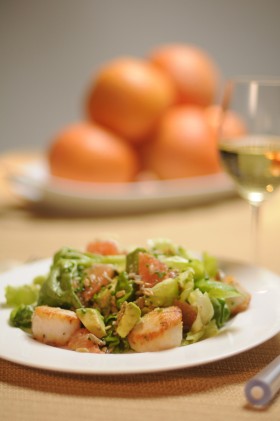Last Updated on March 4, 2016
 Makes 4 Servings
Makes 4 Servings
Hands-On Time: 25 Minutes
Total Preparation Time: 25 Minutes
Ingredients
1 c all-purpose flour
3/4 pound medium sea scallops
Kosher salt and freshly ground black pepper
1/2 c vegetable oil
1/3 c fresh grapefruit juice
1 small shallot
1 T unseasoned rice vinegar
1/8 t sugar
1 small grapefruit (preferably pink)
2 small heads butter lettuce
1 ripe Hass avocado
20 medium chives or 1 medium scallion, green part only
1/4 c sunflower seeds
Directions
1. Spread out the flour in a pie plate lined with wax paper or parchment. Season the scallops with salt and pepper to taste. Working in batches, toss the scallops in the flour, lifting the wax paper or both sides to move the scallops around, transfer the scallops to a strainer and shake off the excess flour.
2. Heat 2 tablespoons vegetable oil in a large skillet over medium heat until hot. Add the scallops to the skillet and sauté for 2 to 3 minutes per side, or until just cooked through. Transfer the scallops to a plate using tongs and set aside to cool to room temperature.
3. Put the grapefruit juice in a small saucepan or skillet and simmer until it has reduced to 2 tablespoons; transfer it to a small bowl. Finely chop the shallot (about 2 tablespoons); add it to the reduced grapefruit juice along with the rice vinegar, 1/4 teaspoon salt, and sugar. Whisk until the sugar and salt have dissolved. Gradually whisk in the remaining 6 tablespoons vegetable oil. Whisk in some of the juices that have accumulated on the scallop plate until the dressing reaches the desired consistency.
4. Peel and section the grapefruit; cut each section in half. Tear the lettuce into bite-size pieces (about 4 cups). Halve, seed, peel, and slice the avocado; thinly slice the chives crosswise (about 1 tablespoon). Toss the lettuce with 1/3 cup dressing.
5. Mound the lettuce on each of 4 plates and top with the scallops, avocado, and grapefruit. Sprinkle with the chives and sunflower seeds and drizzle with the remaining grapefruit dressing.
Cook’s Notes
There are two main kinds of avocados you can find in the market – the large Florida variety and the smaller California/Mexican variety. It used to be that it was easier to find a Florida avocado but now the tables have turned. The smaller California/Mexican avocado (the most famous of which is the Haas) has a higher fat content and richer taste. Caribbeans and Floridians tend to prefer the large variety – it is what they grew up with. I can’t blame them.
When you are at the store gently hold the avocado and press it gently with your hand to see how much it gives (poking it with your finger can bruise it). If it is rock hard it is unripe; if it gives a little it is getting ripe; if it is very soft it is ready for its guacamole moment. Often the darker the color, the riper the fruit but that is not always a reliable indicator. If you buy rock hard avocados and want to speed up the ripening process which can take 4 to 5 days, put the fruit in a paper bag with an apple or banana and the ethylene gas from the other fruits will move the ripening along. If an avocado becomes ripe and you can’t eat it that night, pop it into the fridge. It will keep for two days in the fridge before it starts to lose taste and texture.
According to the California Avocado Commission, avocados can be frozen if they are pureed first. They suggest that you ripen the fruit until it is just soft enough to yield to gentle pressure, remove the peel and pit, and puree the flesh with 1/2 tablespoon lemon juice for every avocado. Package the puree in firm freezer containers and use it within 4 to 5 months. It is best to add the other ingredients for your guacamole to the thawed puree just before serving it.
There are two varieties of Rice vinegar – seasoned and unseasoned. What is the difference? The seasoned variety has both sugar and salt added. So make sure you use the kind of rice vinegar specified in the recipe. Rice vinegar is lower in acid than most other vinegars so it is a good choice when you want a more mellow, less acidic end result. It also fights less with wine when you are pairing a salad with wine. High acid vinegars do not play nicely with wine.
Chardonnay and sea scallops are an ethereal pairing. The richness and body of Chardonnay is the perfect accompaniment for scallops. Chardonnay’s characteristic citrus notes are like a squeeze of lemon on any seafood dish, adding brightness to this scallop salad.



I want to thank you for that amazing salad and wonderful tasty and easy to make